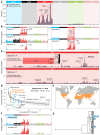Somatic evolution and global expansion of an ancient transmissible cancer lineage
- PMID: 31371581
- PMCID: PMC7116271
- DOI: 10.1126/science.aau9923
Somatic evolution and global expansion of an ancient transmissible cancer lineage
Abstract
The canine transmissible venereal tumor (CTVT) is a cancer lineage that arose several millennia ago and survives by "metastasizing" between hosts through cell transfer. The somatic mutations in this cancer record its phylogeography and evolutionary history. We constructed a time-resolved phylogeny from 546 CTVT exomes and describe the lineage's worldwide expansion. Examining variation in mutational exposure, we identify a highly context-specific mutational process that operated early in the cancer's evolution but subsequently vanished, correlate ultraviolet-light mutagenesis with tumor latitude, and describe tumors with heritable hyperactivity of an endogenous mutational process. CTVT displays little evidence of ongoing positive selection, and negative selection is detectable only in essential genes. We illustrate how long-lived clonal organisms capture changing mutagenic environments, and reveal that neutral genetic drift is the dominant feature of long-term cancer evolution.
Copyright © 2019 The Authors, some rights reserved; exclusive licensee American Association for the Advancement of Science. No claim to original U.S. Government Works.
Conflict of interest statement
Figures



Comment in
-
Cancer cell evolution through the ages.Science. 2019 Aug 2;365(6452):440-441. doi: 10.1126/science.aay2859. Science. 2019. PMID: 31371596 Free PMC article. No abstract available.
References
-
- Strakova A, Murchison EP. The cancer which survived: insights from the genome of an 11000 year-old cancer. Curr Opin Genet Dev. 2015;30:49–55. - PubMed
-
- Blaine DP. A domestic treatise on the diseases of horses and dogs. T. Boosey; London: 1810.
Publication types
MeSH terms
Grants and funding
LinkOut - more resources
Full Text Sources
Other Literature Sources

